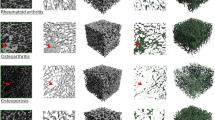Abstract
Disuse bone atrophy was induced in 10 adult dogs by means of brachial plexus section and/or elbow disarticulation. After 9 to 12 weeks of disuse intact humeri were examined by X-ray, and their physical properties determined. Thewhole humeri were isolated, defatted, dried to constant weight, and their mineral and collagen content determined.
Eight out of 10 experimental (non-used) humeri demonstrated evidence of decreased radiodensity. The non-used limb demonstrated parallel loss in dry, fat-free weight (−23.2%), in collagen (−25.3%), and in mineral (−26.1%), as compared to the normal limb. The data indicated that the major portion of the lost bone tissue in disuse osteoporosis is replaced by water, fat, and other unidentified organic materials rather than fibrous tissue, and that collagen is lost in equal proportion to mineral. The proportionatelly greater loss of collagen and mineral than of dry, fat-free weight appears to be due to an increase of non-collagenous, non-lipid organic material, presumably protein.
Résumé
Atrophie osseuse d'immobilisation était induite par section de la plexus brachial et/ou désarticulation de la coude. Après 9 bis 12 semaines de désuétude huméri intactes furent examinés par rayons X et leur qualités physiques déterminés. Les humérientiers furent isolés, dégraissés, desséchés au poids constant, et leur teneur en cendre d'os et collagène déterminés.
Huit des 10 huméri immobilisés monstrérent radiodensité diminué. La jambe inusitée monstra perte parallèle en poids sec et poids sans gras (−23.2%), en collagène (−25.3%), et en cendre d'os (−26.1%) en comparaison de la jambe normale. Les données monstrèrent que la portion plus grande du tissu osseux perdu en atrophie osseuse d'immobilisation est remplacée par de l'eau, du gras, et des autres matériels organiques inconnus plutôt que par tissu fibreux, et que collagène est perdu en proportion du minéral. La perte proportionellement plus grande du collagène et de la cendre d'os que du poids sec et poids san gras semble dû à une augmentation du matériel organique, non-collagéne, non-lipide, kprobablement protéine.
Zusammenfassung
Immobilisations-Knochenatrophie wurde in 10 erwachsenen Hunden herbeigeführt durch Brachialplexusschnitt und/oder Ellenbogenexartikulation. Nach 9–12 Wochen der Immobilisation wurden die intakten Humeri unter Röntgenstrahlen untersucht und ihre physischen Eigenschaften bestimmt. Derintakte Humerus wurde isoliert, entfettet, zu konstantem Gewicht getrocknet und der Knochenaschengehalt und Kollagengehalt bestimmt.
Acht der 10 experimentellen (immobilisierten) Humeri demonstrierte Beweis von verringerter Röntgendichte. Die immobilisierte Extremität zeigte ähnlichen Verlust in trockenem, fettfreiem Gewicht (−23,2%) in Kollagen (−25.3%) und Knochenasche (−26,1%) im Vergleich zur normalen Extremität. Die Date deuten an, daß der Hauptanteil des Verlustes des Knochengewebes (bei Immobilisations-Knochenatrophie) von Wasser, Fett und anderen unidentifizierten organischen Substanzen ersetzt wird, als von Faserngewebe und daß Kollagen und Knochenasche im gleichen Verhältnis verloren gehen. Der größere, proportionale Verlust an Kollagen und Knochenasche, eher als der Verlust an fettfreiem Gewicht, scheint in der Zunahme an nicht kollagener, nicht lipoider, organischer Substanz, vermutlich Protein, zu liegen.
Similar content being viewed by others
References
Allison, N., andB. Brooks: Bone atrophy. An experimental and clinical study of the changes in bone which result from non-use. Surg. Gynec. Obstet.33, 250–260 (1921).
Armstrong, W. D.: Bone growth in paralyzed limbs. Proc. Soc. exp. Biol. (N.Y.)61, 358–362 (1946).
—, andM. Gouze: Influence of estradiol and testosterone propionates on skeletal atrophy from disuse on normal bones of mature rats. Endocrinology36, 313–322 (1945).
Burdeaux, B. D., andW. J. Hutchnison: Studies in osteoporosis following fractures. Surg. Forum2, 434–437 (1952).
Gedalia, I., A. Schwartz, J. Sela, andE. Gazenfield: Effects of fluoride intake on disuse atrophy of bone in rats. Proc. Soc. exp. Biol. (N. Y.)122, 657–660 (1966).
Geiser, M., andJ. Trueta: Muscle action, bone rarefaction and bone formation. J. Bone Jt Surg. B40, 282–311 (1958).
Gong, J. K., J. S. Arnold, andS. H. Cohn: Composition of trabecular and cortical bone. Anat. Rec.149, 325–332 (1964).
Grey, E. G., andG. L. Carr: An experimental study of the factors responsible for noninfectious bone atrophy. Bull. Johns Hopk. Hosp.26, 381–385 (1915).
Klein, L.: The action of collagenase on native collagen. Ph. D. Thesis, Boston University 1958.
—, andJ. J. de Jak: Sequential changes of urinary hydroxyproline and serum alkaline phosphatase in acute paraplegia. Med. Serv. J. Can.22, 524–533 (1966).
Landoff, G. A.: Experimental studies on bone atrophy resulting from immobilization and acute arthritis. Acta chir. scand., Suppl.71, 1–198 (11942).
McLean, F. C., andM. R. Urist: Bone. An introduction to the physiology of skeletal tissue, 2nd ed, p. 215. Chicago: Chicago University Press 1961.
Mishima, H.: Biochemical studies on metabolic mechanism in experimental bone atrophy. Sapporo med. J.25, 123–140 (1964).
Neuman, R. E., andM. A. Logan: The determination of collagen and elastin in tissues. J. biol. Chem.182, 549–556 (1950a).
—: The determination of hydroxyproline. J. biol. Chem.184, 299–306 (1950b).
Pottorf, J. L.: An experimental study of bone growth in the dog. Anat. Rec.10, 234–235 (1916).
Robison, R. A., andS. R. Elliott: The water content of bone. J. Bone. Jt Surg. A39, 167–187 (1957).
Steindler, A.: Physical properties of bone. Arch. phys. Ther. (Omaba)17, 336–345 (1936).
Stover, B. J., andW. S. S. Jee: Some effects of long-term alpha irradiation on the composition and structure of bone. Hlth Phys.9, 267–275 (1963).
Strobino, L. J., andL. E. Farr: The relation of age and function of regional variations in nitrogen and ash content of bovine bones. J. biol. Chem.178, 599–609 (1949).
Weinmann, J. P., andH. Sicher: Bone and bones, fundamentals of bone biology, 2nd ed., p. 15. St. Louis: C. V. Mosby Co. 1955.
Author information
Authors and Affiliations
Additional information
This investigation was supported in part by Public Health Service Grants Tl-AM-5437 and HD-00669, and in part by the Rainbow Hospital Research Fund and Easter Seal Research Foundation.
Rights and permissions
About this article
Cite this article
Klein, L., Kanefield, D.G. & Heiple, K.G. Effect of disuse osteoporosis on bone composition: the fate of bone matrix. Calc. Tis Res. 2, 20–29 (1968). https://doi.org/10.1007/BF02279190
Received:
Issue Date:
DOI: https://doi.org/10.1007/BF02279190




